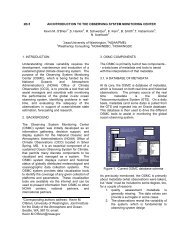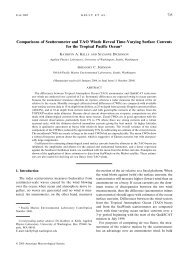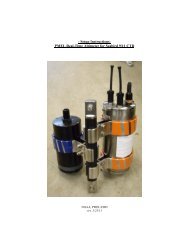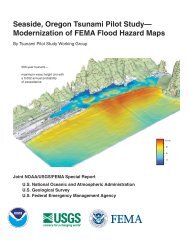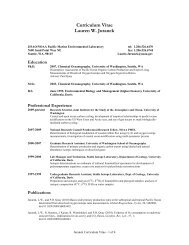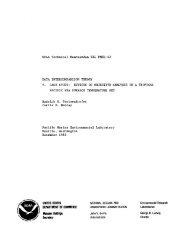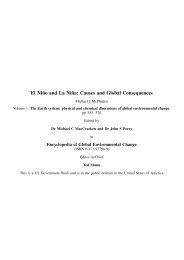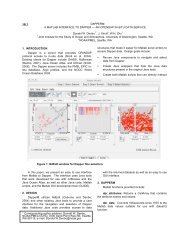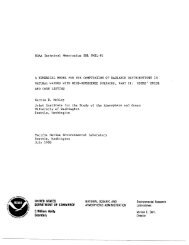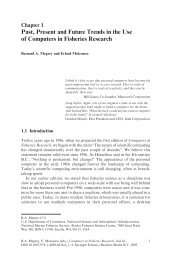OCean aCidiFiCaTiOn ThreaTening Our OCeanS - Pacific Marine ...
OCean aCidiFiCaTiOn ThreaTening Our OCeanS - Pacific Marine ...
OCean aCidiFiCaTiOn ThreaTening Our OCeanS - Pacific Marine ...
You also want an ePaper? Increase the reach of your titles
YUMPU automatically turns print PDFs into web optimized ePapers that Google loves.
MAGAZINE<br />
No. 4<br />
2010<br />
The CirCle<br />
<strong>OCean</strong> <strong>aCidiFiCaTiOn</strong><br />
<strong>ThreaTening</strong> <strong>Our</strong> <strong>OCean</strong>S<br />
PUBLISHED BY THE WWF GLoBaL aRCTIC PRoGRaMME<br />
Chaotic chemistry experiment 6<br />
Fishing for hope 18<br />
Southern discomfort 22
Photo: British antarctic Survey (BaS).ˆ<br />
The Circle 4.2010<br />
The Circle is published quarterly by the<br />
WWF Global arctic Programme. Reproduction<br />
and quotation with appropriate<br />
credit are encouraged. articles by<br />
non-affiliated sources do not necessarily<br />
reflect the views or policies of WWF.<br />
Send change of address and subscription<br />
queries to the address on the right.<br />
We reserve the right to edit letters for<br />
publication, and assume no responsibility<br />
for unsolicited material.<br />
2 The Circle 4.2010<br />
Contents<br />
AlAnnA Mitchell: eDitORiAl: Ocean acidification is invisible 3<br />
in briefs 4<br />
RichARD Feely: Acid and the Arctic Ocean, our chaotic chemistry experiment 6<br />
Steve SuMiDA and BRuce WRight: Alaskan waters become the battle ground – again 10<br />
ulF RieBeSell; Big questions, big test tubes 12<br />
helen FinDlAy: On thinning ice 15<br />
lAuRA eDWARDS: At the ice Base – the research begins 17<br />
AlAn PARkS: Fishing for hope in Alaska 18<br />
ROB nicOll: Southern discomfort – Antarctic waters fast changing 22<br />
the picture 24<br />
<strong>OCean</strong> <strong>aCidiFiCaTiOn</strong><br />
Publisher:<br />
WWF Global arctic Programme,<br />
Po Box 6784 St olavs plass<br />
N-0130 oslo, Norway<br />
Ph: +47 22 03 65 00<br />
Fax: +47 22 20 06 66<br />
Internet: www.panda.org/arctic<br />
Editor in Chief: Clive Tesar, ctesar@wwf.no<br />
Editor: Becky Rynor, brynor@wwf.no<br />
Design and production:<br />
Film & Form/Ketill Berger,<br />
ketill.berger@filmform.no<br />
Printed at Merkur-Trykk aS<br />
Date of publication: December, 2010.<br />
ISSN 2074-076X = The Circle (oslo)<br />
CoVER:<br />
arctic pteropods commonly<br />
known as sea butterflies.<br />
“Pteropods are a particularly<br />
important food source for<br />
juvenile fish such as salmon<br />
and pollock.”<br />
Dr. Richard Feely, page 9.<br />
Photo from:Dr. Russell R. Hopcroft Professor, Institute<br />
of <strong>Marine</strong> Science, University of alaska Fairbanks
editorial<br />
Ocean acidification is invisible<br />
tO the eye, first of all. Just looking at it, you can’t tell<br />
that the water’s fundamental chemical composition – the<br />
dance of its hydrogen ions – has changed.<br />
It’s invisible on the political front, too. Off the radar.<br />
Excluded from international carbon discussions, including<br />
the most recent round in Mexico.<br />
That’s despite the fact that scientists are now worried<br />
that the growing acidity of the ocean is at least as big a<br />
threat to life on the planet as global climate change.<br />
How? When we burn fossilized plants and animals –<br />
we call them fuels – we are putting the carbon from an<br />
ancient age into the atmosphere. So far, we’ve increased<br />
the concentration of carbon<br />
dioxide in the atmosphere from<br />
less than 0.03 per cent to nearly<br />
0.04 per cent. That’s higher than<br />
it’s been in millions of years.<br />
In the atmosphere, that carbon<br />
dioxide acts like a blanket,<br />
keeping heat near the planet’s<br />
surface, inert and powerful<br />
enough to shift climate.<br />
But about a third of that ancient<br />
carbon has been absorbed<br />
by the ocean’s surface, molecule<br />
by molecule, in an inexorable<br />
exchange between the air and<br />
sea. In the ocean, carbon dioxide<br />
is not inert. It reacts chemically<br />
with water to produce carbonic<br />
acid.<br />
Now, a couple of centuries<br />
into the fossil-fuel-burning<br />
industrial revolution, we’ve put<br />
so much ancient carbon into the<br />
atmosphere that the ocean has<br />
become about 30 per cent more<br />
acidic than before we began.<br />
That’s more acidic than the<br />
ocean has been for about 55 million<br />
years.<br />
The implications? They<br />
cascade through the oceanic<br />
chemical soup that is the basic<br />
medium of life on the planet. contributing to a solution.<br />
More acidity means less avail-<br />
n ReADeRS OF the ciRcle are accustomed to<br />
editorials that frame the issue we’re examining<br />
in each edition, along with information about<br />
WWF solutions and initiatives. We pride ourselves<br />
on being a solutions-oriented organization.<br />
However, ocean acidification is too new<br />
and the research too incomplete for us to fully<br />
understand how to tackle this growing threat to<br />
our oceans. We are working with organizations<br />
such as the Catlin arctic Survey, which you can<br />
read about in this edition that spent weeks on<br />
the sea ice to conduct research into the effects<br />
of ocean acidification. another article features<br />
the team of Dr. Ulf Riebesell, which lugged<br />
two tonnes of equipment to Svalbard, then<br />
posted 24-hour watches over their experiments<br />
aimed at analyzing the impact of acidification<br />
on plankton communities. This sort of cutting<br />
edge research will help inform further actions,<br />
although it already seems clear that there will<br />
be changes to the ecology of the arctic ocean,<br />
and that the root cause of these changes is<br />
the amount of carbon dioxide that people are<br />
pumping into the atmosphere. This is our first<br />
concerted effort to tackle ocean acidification<br />
at a circumpolar level, and to bring together<br />
some of the experts urging and taking action.<br />
as alanna Mitchell writes, “we need to make<br />
ocean acidification visible.” The WWF Global<br />
arctic Programme believes that by increasing<br />
its visibility here through The Circle, that we are<br />
able calcium. That means creatures that need calcium<br />
to make shells, bones and bony structures are having<br />
trouble.<br />
Scientists are finding that corals are scrambling to make<br />
their reefs, oyster shells are thinner, some plankton are using<br />
more energy making shells than doing other functions<br />
critical to the basic workings of the ocean.<br />
Along with that, the vulnerable larvae of<br />
oysters, snails and lobsters are struggling<br />
to mature. Fish become stupid, swimming<br />
toward predators instead of away because<br />
of an acid-made shift in their ability to<br />
smell. And these<br />
Clive Tesar, editor-in-chief<br />
are just a few of<br />
the effects scien- AlAnnA Mitchell is<br />
tists have taken a a journalist and author<br />
look at.<br />
whose latest book, Sea-<br />
The colder the sick: The global ocean<br />
water, the more in crisis, has become an<br />
quickly it ab- international bestseller. It<br />
sorbs carbon di- won the Grantham Prize<br />
oxide gas, and so for excellence in environ-<br />
the more acidic. mental reporting.<br />
That means www.alannamitchell.com<br />
the Arctic and<br />
Southern Oceans<br />
are becoming<br />
acidic about<br />
twice as fast as the average. A<br />
recent study calculated that the<br />
northern ocean will be the first<br />
in the world to hit the point<br />
of no return with dangerous,<br />
systemic acidification. By the<br />
end of this decade, 10 per cent of<br />
the Arctic will be so acidic it will<br />
damage, rather than foster, life.<br />
Unless we do something. The<br />
key is to sharply reduce carbon<br />
emissions into the atmosphere<br />
and the ocean. Halting ocean<br />
acidification has to be a priority<br />
at every round of global climate<br />
change discussions. And we<br />
need to make ocean acidification<br />
visible.<br />
The Circle 4.2010 3
in brief<br />
WWF at Japan<br />
conference<br />
DiRectOR OF the WWF<br />
Global Arctic Programme,<br />
Alexander Shestakov, hosted<br />
a side event at the 10th meeting<br />
of the Conference of the<br />
Parties to the Convention on<br />
Biological Diversity (COP-<br />
10) in Nagoya, Japan in<br />
October. “When Parks are not<br />
Enough,” delivered a strong<br />
warning about ecosystem<br />
resilience and change in the<br />
Arctic.<br />
“Warming in the Arctic is<br />
proceeding at twice the global<br />
rate,” Shestakov says. “This<br />
challenges the resilience of<br />
arctic ecosystems and calls<br />
for a major re-think of arctic<br />
conservation.”<br />
raCer moves<br />
forward<br />
A SlAte OF exPeRtS met<br />
in Ottawa to help WWF’s<br />
Global Arctic Programme<br />
fine-tune a project designed<br />
to identify, map and raise<br />
awareness about circumarctic<br />
regions that are resilient<br />
to change. RACER – Rapid<br />
Assessment of Circumarctic<br />
Ecosystem Resilience – “is<br />
designed to quickly provide<br />
guidance on conservation<br />
options in the Arctic in the<br />
face of rapid change,” says<br />
Martin Sommerkorn, WWF’s<br />
senior climate change advisor.<br />
“RACER will identify<br />
those areas that are underpinning<br />
future viability of<br />
Arctic ecosystems, including<br />
4 The Circle 4.2010<br />
people.” Sommerkorn says he<br />
was particularly encouraged<br />
by the support for RACER<br />
expressed by scientists,<br />
technical consultants and<br />
other experts who attended<br />
the week of workshops in Ottawa,<br />
Canada. “There is solid<br />
recognition that an assessment<br />
embracing the changes<br />
to come is critically needed<br />
and that assessing resilience<br />
is the right way to move<br />
forward,” he said. RACER is<br />
designed to provide guidance<br />
to government, industry and<br />
other stakeholders to ensure<br />
functional arctic ecosystems.<br />
arctic fox<br />
WWF-SWeDen is involved in a<br />
new program aimed at boosting<br />
and protecting the arctic<br />
fox population in Scandinavia.<br />
“The Felles Fjellrev program<br />
is attempting to repopulate<br />
areas where no arctic<br />
foxes are currently breeding,”<br />
says WWF spokesman Tom<br />
Arnbom. “If successful, then<br />
arctic Council meet in Torshavn,<br />
Faeroe Islands.<br />
the two, smaller isolated<br />
areas for this species will<br />
broaden and grow into one<br />
large habitat between Norway<br />
and Sweden that would allow<br />
fox populations to breed with<br />
each other, strengthening the<br />
gene pool. ”<br />
Arnbom says the number<br />
of arctic foxes in Sweden is<br />
a fraction of what it was 150<br />
years ago – just 130 foxes<br />
according to numbers from<br />
summer, 2010 – due to<br />
increased hunting in the 19th<br />
and 20th century. But he says<br />
a recent shortage of small rodents<br />
– the fox’s main source<br />
of food – is also a factor.<br />
“The Scandinavian lemming<br />
has been particularly<br />
scarce,” Arnbom says. “To<br />
help the arctic fox in Scandinavia,<br />
supplementary feeding<br />
with dog pellets and removal<br />
of predatory red foxes close<br />
to arctic fox dens has made a<br />
difference in survival rates.”<br />
Arctic fox populations<br />
suffered severe declines in<br />
2008-2009 when only a<br />
few pups out of each litter<br />
survived. But the summer<br />
Photo: Clive Tesar<br />
of 2010 saw the best survival<br />
rate in 35 years. In total, 24<br />
pairs raised pups, largely due<br />
to a combination of active<br />
management and relatively<br />
high rodent population. By<br />
late autumn, numerous lemming<br />
tracks were observed<br />
in arctic fox territory. “If this<br />
trend continues, there could<br />
be an incredible increase of<br />
lemmings by next summer,<br />
which would result in a boom<br />
in the arctic fox population<br />
throughout Scandinavia,”<br />
Arnbom says.<br />
economic forum<br />
champions WWF<br />
management plan<br />
for Barents Sea<br />
WWF-RuSSiA’S initiative for<br />
a Complex Management<br />
Plan for the Barents Sea was<br />
highlighted at the Second<br />
Arctic Economic Forum in<br />
Murmansk in October. The<br />
Council flies search<br />
& rescue pilot<br />
glOBAl ARctic PROgRAMMe communications<br />
director Clive Tesar represented<br />
WWF at the October Arctic Council<br />
meeting in Torshavn, Faeroe Islands.<br />
The meeting heard a progress report on a<br />
search and rescue agreement being negotiated<br />
between the arctic states. “While<br />
search and rescue is not our core business,<br />
the fact that it is intended to be a legally<br />
binding agreement negotiated under the<br />
auspices of the Arctic Council is momentous,”<br />
says Tesar. “If successful, this would<br />
be the first agreement of its kind leading to<br />
a significant strengthening of the council<br />
as a multilateral instrument.”
Bear necessities<br />
in OctOBeR Arctic NI polar<br />
bear specialist Geoff York<br />
gave a presentation on<br />
WWF’s efforts in bear/human<br />
conflict reduction at<br />
the Southern Hudson Bay<br />
Where the<br />
bears are:<br />
yORk AlSO scored some<br />
ice time with the bears on<br />
the shores of Hudson Bay<br />
in November along with<br />
some of the world’s leading<br />
polar bear and climate<br />
researchers. York and other<br />
chairman of the Murmansk<br />
regional Duma (legislature),<br />
Evgeny Nikora, said there<br />
is “growing conflict in the<br />
numerous approaches in<br />
monitoring sea activity and<br />
degradation of sea ecosystems<br />
in areas of intense<br />
economic development.”<br />
WWF Russia wants to see<br />
principles such as an ecosystem<br />
approach to management,<br />
adaptive management<br />
and preservation of species<br />
fixed in international law<br />
and national legislation as in<br />
other leading sea countries.<br />
Polar Bear Recovery Plan<br />
Workshop in northern<br />
Ontario, Canada. “Ontario is<br />
home to the southern-most<br />
population of polar bears in<br />
the world and climate change<br />
is considered the greatest<br />
threat to the survival of<br />
these bears,” York says. “In<br />
experts were able to do live<br />
broadcasts to audiences<br />
around the world via the<br />
Polar Bears International<br />
“Tundra Buggy 1” mobile<br />
studio. “While we were with<br />
the bears waiting for the sea<br />
ice to form, world leaders<br />
were gathering to meet in<br />
Cancun, Mexico, to discuss<br />
progress on a global climate<br />
norway backing<br />
down on CO 2<br />
reduction<br />
promises<br />
WWF iS pressuring the Norwegian<br />
government to reject<br />
an application by The Store<br />
Norske Kullkompani (SNSK)<br />
to extend coal mining operations<br />
on the arctic archipelago<br />
of Svalbard.<br />
“Extended coal mining<br />
Hudson Bay and James Bay,<br />
climate change is causing<br />
sea ice to thaw earlier and<br />
freeze up later. It’s believed<br />
this reduces the amount of<br />
time polar bears can spend<br />
on the ice feeding on seals<br />
to put on fat to support their<br />
seasonal fast.” Over the last<br />
deal. It was extremely<br />
gratifying to be able to speak<br />
with concerned citizens<br />
around the globe about the<br />
decline of this iconic species.”<br />
York also completed<br />
a fall coastal survey of the<br />
entire coast of the province<br />
with Manitoba Conservation<br />
and Polar Bears International.<br />
This was the first such<br />
on Svalbard directly contradicts<br />
Norway’s ambitious<br />
C02 reduction goals and its<br />
promised climate change<br />
commitments,” says WWF-<br />
Norway’s head of climate<br />
change and energy, Arild<br />
Skedsmo. “Even considering<br />
this application flies in the<br />
face of what the Norwegian<br />
government has promised to<br />
do to reduce greenhouse gas<br />
emissions.”<br />
The coal is largely used for<br />
energy production. Its main<br />
markets are Germany and the<br />
Netherlands.<br />
30 years, the break-up of<br />
sea ice has occurred about<br />
9.5 days earlier per decade<br />
in northern James Bay and<br />
between five and eight days<br />
earlier per decade along the<br />
southern Hudson Bay coast<br />
of Ontario.<br />
survey of its kind conducted<br />
at this time of year. “This<br />
will be a useful baseline,”<br />
says York. “In future years<br />
we can look at this survey<br />
of the distribution of bears<br />
and their numbers along the<br />
coast to get a better idea of<br />
how they’re reacting to the<br />
longer ice-free periods.”<br />
SNSK’s application to<br />
extend coal mining on the archipelago<br />
is currently undergoing<br />
environmental impact<br />
assessments. If approved, the<br />
construction of infrastructure<br />
for the new mine could begin<br />
as early as this summer.<br />
“The government of<br />
Norway is guilty of speaking<br />
rhetoric on climate change,”<br />
says Skedsmo. “If Norway<br />
isn’t prepared to make even<br />
miniscule concessions on<br />
economic activities such as<br />
coal mining, how can we<br />
expect anyone else to?”<br />
The Circle 4.2010 5
how the oceans are changing<br />
acid and the arctic Ocean, our<br />
chaotic chemistry experiment<br />
Spanning an area of slightly over 14 million square kilometres, the Arctic Ocean<br />
is one of the most pristine and productive regions on earth, supporting surprising<br />
numbers of birds, fish, and marine mammals. Concern over the rapid loss of<br />
ice cover over the past several decades from the substantial climate change occurring<br />
in the region has led many scientists to speculate about the future health<br />
and well-being of its marine ecosystems. Oceanographer Dr. RichARD Feely explains<br />
how the Arctic Ocean now faces another threat – the same carbon dioxide<br />
surplus that is largely responsible for climate change is also altering the basic<br />
chemistry of the ocean. ➽<br />
<strong>Pacific</strong> walrus males at “haul-out” Round Island, alaska,<br />
6 The Circle 4.2010
The Circle 4.2010 7<br />
Photo: Kevin Schafer / WWF-Canon
OveR the PASt 200 years the release of<br />
carbon dioxide (CO ) from our collective<br />
2<br />
industrial and agricultural activities has<br />
resulted in atmospheric CO concentra-<br />
2<br />
tions that have increased significantly.<br />
The atmospheric concentration of CO is 2<br />
now higher than experienced<br />
on Earth<br />
for at least the last<br />
800,000 years,<br />
and is expected to<br />
DR. RichARD A. Feely continue to rise.<br />
is a Senior Scientist When carbon diox-<br />
at the Noaa <strong>Pacific</strong> ide is absorbed by<br />
<strong>Marine</strong> Environmental the oceans it reacts<br />
Laboratory in Seattle with seawater to<br />
and is a professor form carbonic acid.<br />
at the University of The oceans have<br />
Washington School absorbed approxi-<br />
of oceanography. His mately 525 billion<br />
major research areas tons of carbon<br />
are carbon cycling in dioxide from the<br />
the oceans and ocean<br />
acidification processes.<br />
He co-chairs<br />
the U.S. CLIVaR/Co2 Repeat Hydrography<br />
Program and is a<br />
member of the Steering<br />
Committee for<br />
the U.S. Carbon and<br />
Biochemistry Program.<br />
He was awarded the<br />
Department of Commerce<br />
Gold award in<br />
2006 for research on<br />
ocean acidification.<br />
8 The Circle 4.2010<br />
“…<strong>OCean</strong> <strong>aCidiFiCaTiOn</strong><br />
COuld aFFeCT SOme OF<br />
The mOST Fundamen-<br />
Tal BiOlOgiCal and<br />
ChemiCal prOCeSSeS OF<br />
The Sea in COming de-<br />
CadeS.”<br />
atmosphere, or about one quarter of<br />
the human-introduced carbon dioxide<br />
emissions released over the last two and<br />
a half centuries. This natural process of<br />
absorption has benefited humankind by<br />
significantly reducing the greenhouse<br />
gas levels in the atmosphere and mini-<br />
Weisweiler power in North-Rhine Westphalia.<br />
mizing some of the impacts of global<br />
warming.<br />
However, the ocean’s uptake of 22<br />
million tons of carbon dioxide per day<br />
is starting to have an impact on the<br />
chemistry of seawater. The pH of our<br />
ocean surface waters has already fallen<br />
by about 0.1 units from an average of<br />
about 8.2 to 8.1 since the beginning of<br />
the industrial revolution (on the pH<br />
scale, 7.0 is neutral, with points higher<br />
on the scale being “basic” and points<br />
lower being “acidic”). Estimates of<br />
future atmospheric and oceanic carbon<br />
dioxide concentrations indicate that by<br />
the end of this century the surface ocean<br />
pH decrease would result in a pH that is<br />
lower than it has been for more than 20<br />
million years.<br />
When CO 2 reacts with seawater, fundamental<br />
chemical changes occur that<br />
cause a reduction in seawater pH. The<br />
Photo: andrew Kerr/WWF-Canon
The oceans are acidifying fast<br />
Every day, more than 20 million<br />
tons of carbon dioxide are<br />
released into the atmosphere<br />
from the burning of fossil<br />
fuels. Nearly one-third of this<br />
pollution is absorbed by our<br />
Coal deposits<br />
interaction between CO 2 and seawater<br />
depletes the availability of carbonate<br />
ion, critical to shell formation for marine<br />
animals such as corals, plankton, and<br />
shellfish. This phenomenon, commonly<br />
called “ocean acidification,” could affect<br />
some of the most fundamental biological<br />
and chemical processes of the sea in<br />
coming decades. The Arctic Ocean’s cold<br />
waters tend to absorb carbon dioxide<br />
more rapidly than is absorbed by the<br />
warmer seawater to the south, making<br />
it more vulnerable to acidification.<br />
Over the last three decades, retreat of<br />
summertime sea ice cover has exposed<br />
shelf waters to the atmosphere and has<br />
allowed additional absorption of carbon<br />
dioxide. The combination of these processes<br />
accelerates the rate at which pH<br />
decreases in the region.<br />
Fossil fuel<br />
emissions<br />
oceans.<br />
over the past several<br />
decades, we have pumped<br />
so much carbon dioxide - into<br />
the oceans that their chemical<br />
composition is changing.<br />
Fossil fuel and<br />
cement production<br />
Oil and gas<br />
deposits<br />
They are acidifying. and they<br />
are doing so at an alarming<br />
rate.<br />
The increasing acidification<br />
of our oceans is already<br />
beginning to alter ecosystems<br />
EffEcts on fish and<br />
shEllfish<br />
Research is showing that ocean acidification<br />
may have negative effects on commercially<br />
important fish and shellfish<br />
larvae. Exposure of fish to lower pH levels<br />
can cause decreased respiration rates,<br />
changes in blood chemistry and changes<br />
in enzymatic activity. The calcification<br />
rates of the edible mussel and <strong>Pacific</strong><br />
“…We Can expeCT TO<br />
See SigniFiCanT impaCTS<br />
ThaT are OF immenSe<br />
impOrTanCe TO<br />
mankind”<br />
Atmosphere<br />
30%<br />
Ocean<br />
and the very food web that<br />
sustains alaska’s fisheries.<br />
Higher acidity levels hamper<br />
the shell-building processes<br />
of species such as crabs,<br />
clams and corals.<br />
Graphic: alaska <strong>Marine</strong> Conservation Council and WWF-alaska<br />
oyster decline with increasing CO 2 levels.<br />
Squid are especially sensitive to ocean<br />
acidification because it directly affects<br />
their blood oxygen transport and respiration.<br />
Sea urchins raised in lower-pH waters<br />
show evidence for inhibited growth<br />
due to their inability to maintain internal<br />
acid-base balance. Scientists have also<br />
seen a reduced ability of marine algae<br />
and free-floating plants and animals<br />
to produce protective carbonate shells.<br />
These organisms are important food<br />
sources for other marine species. One<br />
type of free-swimming mollusk called<br />
a pteropod is eaten by animals ranging<br />
from tiny krill to whales. Pteropods are<br />
a particularly important food source for<br />
juvenile fish such as salmon and pollock.<br />
Ocean acidification research is still<br />
in its infancy, so it is impossible to<br />
The Circle 4.2010 9
predict exactly how the individual species<br />
responses will cascade throughout<br />
the marine food chain and impact the<br />
overall structure of marine ecosystems.<br />
It is clear, however, from the existing<br />
data and from the geologic record that<br />
some plankton and fish species will be<br />
reduced in a high-CO 2 ocean.<br />
Ocean acidification may be one of the<br />
most significant and far-reaching consequences<br />
of the buildup of human-induced<br />
carbon dioxide in the atmosphere.<br />
Results from laboratory, field and<br />
modeling studies, as well as evidence<br />
from the geological record, clearly indicate<br />
that marine ecosystems are highly<br />
susceptible to the increases in oceanic<br />
CO 2 and the corresponding decreases in<br />
pH. Clams, oysters and other calcifying<br />
organisms will experience increasing<br />
difficulty producing their shells. Other<br />
species of fish and shellfish will also be<br />
negatively affected in their physiological<br />
responses due to a decrease in pH<br />
levels of their cellular fluids. Because of<br />
the very clear potential for ocean-wide<br />
impacts of ocean acidification at all<br />
levels of the marine ecosystem, from the<br />
tiniest phytoplankton to zooplankton to<br />
fish and shellfish, we can expect to see<br />
significant impacts that are of immense<br />
importance to mankind.<br />
Ocean acidification is an emerging<br />
scientific issue and much research<br />
is needed before all of the ecosystem<br />
responses are well understood. However,<br />
to the limit that the scientific<br />
community understands this issue right<br />
now, the potential for environmental,<br />
economic and societal risk is quite high.<br />
It demands serious and immediate attention.<br />
Over the next century, if CO 2<br />
emissions are allowed to increase as<br />
predicted, mankind may be responsible<br />
for increasing oceanic CO 2 and making<br />
the oceans more corrosive to calcifying<br />
organisms than at any time since the<br />
last major extinction, over 65 million<br />
years ago. Thus, the decisions we make<br />
about our use of fossil-fuels for energy<br />
over the next several decades will probably<br />
have a profound influence on the<br />
makeup of future marine ecosystems for<br />
centuries or even millennia.<br />
10 The Circle 4.2010<br />
Shipping<br />
alaskan waters become<br />
the battle ground – again<br />
While general fossil fuel emissions are the greatest con-<br />
tributor to ocean acidification, new research suggests<br />
there are other factors that can locally exacerbate acidification,<br />
and introduce other chemical threats. As climate<br />
change reduces arctic ice, Aleut and Pribilof people will<br />
find themselves living at the crossroads of two shipping<br />
lanes – the Great Circle route to Asia and the fabled Northwest<br />
Passage. Steve SuMiDA and BRuce WRight say people like<br />
them who live in the Bering Sea region will be increasingly<br />
exposed to unprecedented levels of virtually unregulated<br />
emissions from high-sulphur shipping fuels.<br />
AlASkAn WAteRS are once again the<br />
battleground for resolving hydrocarbon<br />
pollution. In 1989 the Exxon Valdez<br />
spilled crude oil that spread for hundreds<br />
of miles in the pristine waters<br />
along Alaska’s coast. <strong>Our</strong> understanding<br />
at the time discounted oil as little more<br />
than a semi-noxious pollutant and a<br />
killer of birds. But oil toxicity research<br />
funded by the multi-million dollar settlement<br />
from the Exxon Valdez Oil Spill<br />
Trustee Council changed that almost<br />
benevolent view of oil pollution. We<br />
now know it is thousands of times more<br />
toxic than realized.<br />
<strong>Marine</strong> species have<br />
continued to be affected<br />
long after that<br />
catastrophic spill,<br />
evidenced mostly by<br />
salmon not returning<br />
to spawning<br />
streams. Many other<br />
birds and mammals<br />
were also harmed or<br />
killed.<br />
The pollution caused by burning highsulphur<br />
fuels can have the same toxic<br />
effects. Ships in this region are allowed<br />
to use high-sulphur fuels with 45,000<br />
parts per million sulphur – a much<br />
higher level than those set in most US<br />
waters of 10,000 ppm sulphur content<br />
for the majority of bulk fuel blends.<br />
alEutians, Pribilof islands,<br />
WEstErn alaska rEmain<br />
unProtEctEd<br />
Large container ships, tankers, bulk carriers,<br />
cruise ships and Lakers are significant<br />
contributors<br />
“…Shipping aCTiviTy<br />
and laCk OF emiSSiOn<br />
COnTrOlS Over Sulphur<br />
Will COnTriBuTe TO The<br />
SeriOuS prOBlem OF<br />
<strong>OCean</strong> <strong>aCidiFiCaTiOn</strong>.”<br />
to air pollution in<br />
many of our nation’s<br />
cities and<br />
ports.<br />
Studies by the<br />
US Environmental<br />
Protection<br />
Agency (EPA)<br />
show that emissions<br />
from large<br />
marine vessels
The culprit: carbon dioxide released from burning fossil fuels<br />
pH<br />
Historical and projected pH and dissolved CO2 8.25<br />
-22<br />
8.20 pH<br />
-21<br />
8.15<br />
-20<br />
-19<br />
8.10<br />
-18<br />
8.05<br />
-17<br />
8.00<br />
-16<br />
-15<br />
7.95<br />
-14<br />
7.90<br />
7.85<br />
Carbon dioxide<br />
-13<br />
-12<br />
-11<br />
7.80<br />
-10<br />
7.75<br />
-9<br />
1850 1875 1900 1925 1950 1975<br />
Year<br />
2000 2002 2050 2075 2100<br />
As the ocean concentration of carbon dioxide increases, so does acidity (causing pH to decline).<br />
ocean acidification is happening<br />
now, at a rate and<br />
to a level not experienced<br />
by marine organisms<br />
for more than 20 million<br />
years.<br />
burning bunker fuel within 200 miles of<br />
the U.S. west coast shore can result in<br />
serious impacts to human and environmental<br />
health as well as permanent<br />
environmental degradation as far inland<br />
as the Grand Canyon, a distance of<br />
roughly 800 kilometres. As a result, the<br />
United States negotiated an international<br />
law preventing emissions from<br />
this fuel anywhere within 200 miles of<br />
the U.S. coast – except for the regions<br />
from the Alaska Peninsula, through the<br />
Aleutians and Pribilof Islands, western<br />
Alaska and along the Arctic coast. These<br />
regions remain exposed and unprotected<br />
to bunker fuel burning up to 45,000<br />
parts per million sulphur content<br />
and unprecedented levels of virtually<br />
unregulated emissions. This at a time<br />
ocean acidity has<br />
increased 30% since the<br />
Industrial Revolution and<br />
the rate of change has<br />
increased over the last<br />
20 years. The burning<br />
Source: Feely, Richard A., et al. (2006) Carbon Dioxide and <strong>Our</strong> Ocean Legacy<br />
Dissolved carbon dioxide<br />
(Micromoles/kg)<br />
of fossil fuels releases<br />
carbon dioxide, which gets<br />
absorbed by the oceans<br />
and changes their chemical<br />
composition, making<br />
them more acidic.<br />
Graphic: alaska <strong>Marine</strong> Conservation Council and WWF-alaska<br />
when the EPA requires all fuel for small<br />
marine vessels, highway, and non-road<br />
diesel engines including locomotives to<br />
be limited to 15 ppm sulphur content.<br />
The EPA does not have any emissions<br />
monitoring stations in the Aleutian<br />
region. But the number of vessels moving<br />
through Unimak Pass is large and<br />
increasing, so we can’t begin to know<br />
the exposure level for people living and<br />
working in the Bering Sea region.<br />
We do know increased shipping activity<br />
and lack of emission controls over<br />
sulphur will contribute to the serious<br />
problem of ocean acidification and<br />
nutrient enrichment in the North <strong>Pacific</strong><br />
Ocean through significant increases of<br />
nitrogen and sulphur deposits.<br />
By 2020, international shipping is<br />
expected to account for 10 to more than<br />
25 per cent of total annual sulphur<br />
deposition along the entire Atlantic, Gulf<br />
of Mexico, and <strong>Pacific</strong> coastal areas of<br />
the U.S. The impact of these deposits<br />
will extend inland<br />
for hundreds of kilometres.<br />
This means<br />
International shipping<br />
will contribute<br />
to total annual sul-<br />
Steve SuMiDA is the<br />
phur deposition not<br />
Program Manager/<br />
only along all U.S.<br />
Grant Director, Tanad-<br />
coastal areas, but<br />
gusix Corporation, an<br />
throughout the en-<br />
alaska Native village<br />
tire U.S. land mass,<br />
corporation created<br />
impacting sensi-<br />
under the alaska Native<br />
terrestrial and<br />
tive Claims Settlement<br />
aquatic ecosystems<br />
act.<br />
in the vast interior<br />
and heartland<br />
regions.<br />
Researchers with<br />
a U.S. Forest Service<br />
study conducted<br />
in Southeast Alaska<br />
found evidence of<br />
sulphur emissions<br />
affecting lichen<br />
BRuce WRight is<br />
communities. The an ecologist and<br />
authors concluded senior scientist with<br />
that the main<br />
the aleutian Pribilof<br />
source of sulphur Island association. He<br />
and nitrogen found led the effort to study<br />
in lichens is likely energy issues in the<br />
the burning of fos- aleut region including<br />
sil fuels by cruise the development of a<br />
ships. Lichen are marine transportation<br />
an important food plan.<br />
source for caribou<br />
and there is a<br />
probability that large vessel emissions<br />
are damaging lichens and affecting the<br />
southern Alaska Peninsula caribou herd<br />
which is an important food source for<br />
local subsistence-based cultures. This<br />
herd has been decreasing in size, has<br />
poor calf survival and low pregnancy<br />
rates resulting in a ban on caribou hunting<br />
in this region. One can only imagine<br />
the effects these emissions are having<br />
on the dwindling Bering Sea fishing<br />
stocks.<br />
The Circle 4.2010 11
european project on Ocean acidification<br />
12 The Circle 4.2010<br />
Big questions,<br />
big test tubes
Huge “test tubes” inside eight and a half<br />
metre-high floating frames, are used to investigate<br />
the effects of ocean acidification<br />
on the marine ecosystem in Kongsfjord,<br />
Svalbard, Norway.<br />
By the end of this century,<br />
the projected changes<br />
caused by ocean acidification<br />
will go beyond anything<br />
organisms have experienced<br />
in the last 20 million years<br />
of their evolutionary history.<br />
Arctic waters are home<br />
to a wide range of creatures<br />
that build shells, both freeswimming<br />
and on the ocean<br />
floor, including shell fish,<br />
sea urchins, coralline algae,<br />
and calcareous plankton.<br />
Many of these species<br />
provide crucial links in the<br />
arctic food web, such as the<br />
sea butterflies (pteropods),<br />
which serve as food for<br />
fishes, seabirds and whales.<br />
Dr. ulF RieBeSell reports on<br />
research studying the impacts<br />
of ocean acidification<br />
on plankton communities.<br />
FROM MAy tO July 2010, a group of 35<br />
researchers of the EU-funded European<br />
Project on Ocean Acidification<br />
(EPOCA) conducted the first major CO 2<br />
perturbation experiment in the Arctic<br />
Ocean. Led by the Leibniz Institute<br />
of <strong>Marine</strong> Sciences (IFM-GEOMAR)<br />
nine mesocosms – giant, 17 metre “test<br />
tubes” – were placed in the Kongsfjord<br />
off the north-western coast of Svalbard,<br />
an archipelago in the Arctic constituting<br />
the northernmost part of Norway.<br />
Each mesocosm was filled with<br />
about 50 cubic metres of seawater. The<br />
enclosed plankton community was then<br />
exposed to a range of different CO 2<br />
levels as projected to develop between<br />
now and the middle of the next century<br />
and was closely monitored over a period<br />
of six weeks. The EPOCA scientists,<br />
who stayed at the Ny Ålesund research<br />
The Circle 4.2010 13
ulF RieBeSell has<br />
studied the impacts<br />
station, sampled the<br />
of ocean acidification<br />
mesocosms daily<br />
on marine organisms<br />
with plankton nets,<br />
and ecosystems for<br />
water samplers<br />
the past 15 years. He<br />
and pumps, and<br />
is on the executive<br />
conducted measure-<br />
board of the European<br />
ments.<br />
Project on ocean<br />
EPOCA’s 2010<br />
acidification (EPoCa)<br />
mesocosm cam-<br />
and coordinates the<br />
paign involved<br />
German national<br />
molecular and cell<br />
programme on ocean<br />
biologists, marine<br />
acidification (BIoaCecologists<br />
and<br />
ID). He is a professor<br />
bio-geochemists<br />
at the Leibniz Institute<br />
as well as ocean<br />
of <strong>Marine</strong> Sciences<br />
and atmospheric<br />
(IFM-GEoMaR) in<br />
chemists. The team<br />
Kiel, Germany.<br />
set out to address<br />
a range of urgent<br />
questions concerning<br />
the impacts of ocean acidification on<br />
arctic ecosystems. How will ocean acidification<br />
affect the production of food at<br />
the base of the arctic food web and its<br />
transfer to consumers at higher levels?<br />
How will ocean acidification influence<br />
competition and trophic interactions at<br />
14 The Circle 4.2010<br />
35 scientists took part in the research in Kongsfjord.<br />
various levels of the pelagic ecosystem?<br />
Will there be winners and losers of<br />
ocean acidification?<br />
Another set of questions concerns the<br />
possible consequences for the cycling of<br />
key elements. Will ocean acidification<br />
affect the store of carbon in the Arctic<br />
Ocean? Will it change the turn-over and<br />
balance between the primary building<br />
blocks of life such as carbon, nitrogen<br />
and phosphorus? A third set of questions<br />
concerns the exchange of climaterelevant<br />
gases between ocean and<br />
atmosphere. Will ocean acidification<br />
affect the production of these gases and<br />
if so, will it amplify or dampen global<br />
climate change?<br />
The scientists participating in this<br />
unique campaign, the first of its kind<br />
in polar waters, had to face a range of<br />
technical and logistical challenges. In<br />
addition to the nine mesocosms, each<br />
weighing nearly 2 tonnes, the team<br />
had to transport more than 150 boxes<br />
of scientific equipment to the high<br />
Arctic. IFM-GEOMAR, as the coordinating<br />
institute, received support<br />
from the Greenpeace vessel Esperanza,<br />
which transported the mesocosms and<br />
other heavy equipment from Kiel to Ny<br />
Ålesund and back as part of its 2010<br />
Arctic Campaign. Another challenge was<br />
the risk of damage to the mesocosms<br />
by drifting sea ice and icebergs calving<br />
off the three glaciers extending into the<br />
Kongsfjord. This could only be avoided<br />
by posting 24-hour ice watches and<br />
pushing icebergs off-track with small<br />
boats to keep them from colliding with<br />
the moored mesocosms. Considering<br />
the many unknowns involved in<br />
this endeavour, the experiment went<br />
surprisingly well and according to plan.<br />
The scientists collected nearly 15000<br />
samples and acquired data for over 45<br />
parameters characterizing the responses<br />
of the arctic ecosystem to ocean acidification.<br />
The results of this study will<br />
be presented at various international<br />
conferences in early 2011 and are expected<br />
to provide the first comprehensive<br />
insight into the sensitivities of the<br />
arctic ecosystem to a rapidly acidifying<br />
ocean.
Catlin arctic Survey 2010<br />
On thinning ice<br />
The summer sea-ice melt season of 2010 saw the third lowest ice extent in the satellite<br />
record and continues the trend of a declining summer sea-ice extent seen over the last<br />
three decades. Both the Northwest Passage (above Canada and Alaska) and Northern<br />
Sea Route (above Russia) were both open in September. The disappearance of the ice has<br />
implications for acidification in the Arctic Ocean. Scientist helen FinDlAy recently accompanied<br />
the Catlin Arctic Survey to Nunavut to conduct ocean acidification research. It<br />
was the first expedition to take water samples from the sea ice in winter. Previous Arctic<br />
measurements have been taken from ships in open water during the summer. Here she<br />
comments on the current status of ocean acidification research.<br />
Research shows polar waters are less able to<br />
buffer effects of acidity.<br />
Copyright Catlin arctic Survey<br />
neWly-OPen OceAn waters and reduction in sea-ice<br />
are examples of how the Earth’s climate systems are<br />
changing. These changes have serious consequences<br />
for the uptake of carbon dioxide into the ocean and the<br />
subsequent change in ocean chemistry which results in<br />
oceans becoming more acidic.<br />
Colder waters have a higher<br />
capacity to hold more dissolved<br />
gases, such as CO . That means<br />
2<br />
the Arctic Ocean, for example, can<br />
absorb more CO from the atmos-<br />
2<br />
phere than tropical oceans. The helen FinDlAy was<br />
Arctic Ocean also has naturally an ice base scientist<br />
lower levels of important ions, such on the Catlin arctic<br />
as carbonate ions, making it less Survey in 2010. She<br />
able to buffer changes in acidity. has a PhD in biological<br />
So the Arctic Ocean is particularly oceanography and<br />
vulnerable to ocean acidification. is currently the Lord<br />
Model projections suggest the<br />
Kingsland Research<br />
Arctic could become corrosive to Fellow at Plymouth<br />
calcium carbonate minerals (arago- <strong>Marine</strong> Laboratory,<br />
nite and calcite) in the next 20<br />
UK. She also took<br />
to 50 years. The small amount of part in the European<br />
carbon data that has been collected Project on ocean<br />
from the Arctic Ocean shows that acidification. Her cur-<br />
aragonite undersaturation is alrent research projects<br />
ready occurring seasonally in some include the impact of<br />
areas. However, there are complex ocean acidification<br />
and poorly understood interactions and global warming on<br />
between the sea ice and the flow of marine organisms and<br />
CO between the atmosphere and<br />
2<br />
the ocean. Additionally, the organisms<br />
that live in and under the sea<br />
ecosystem function.<br />
The Circle 4.2010 15
ice play an important role in transporting<br />
carbon between the atmosphere<br />
and the ocean. These organisms could<br />
themselves be at risk from the impacts<br />
of ocean acidification.<br />
For many years it was thought that<br />
sea ice acts as a barrier or “lid” to the<br />
ocean, essentially preventing any flow<br />
of CO 2 , so that when the sea ice melts<br />
and exposes seawater to the atmosphere<br />
there is a flow of CO 2 into the ocean.<br />
This would suggest that as areas of the<br />
Arctic Ocean become free of ice in summer<br />
there could be an increased uptake<br />
of CO 2 into the ocean which will further<br />
exacerbate ocean acidification.<br />
However, recent studies suggest that<br />
the interaction is not quite so straightforward.<br />
As sea-ice forms, the salts in<br />
the water are extruded out into small<br />
channels (brine channels) that flow<br />
through the ice. These brine waters<br />
have highly concentrated levels of CO 2<br />
and buffering compounds (alkalinity),<br />
which can flow into the surface ocean<br />
and could change the dynamics of how<br />
CO 2 transfers between the ocean and<br />
the atmosphere. To further complicate<br />
the system, plants and animals that live<br />
in and under the sea-ice contribute to<br />
transporting carbon by photosynthesis<br />
and respiration, as well as forming calcium<br />
carbonate shells and skeletons.<br />
consEquEncEs could bE<br />
sEvErE<br />
There is growing concern that marine<br />
organisms could be stressed by ocean<br />
acidification. Many oceanic organisms<br />
use carbonate minerals to make shells<br />
and skeletons, but these structures<br />
will dissolve as the seawater becomes<br />
more acidic. Perhaps more importantly,<br />
nearly all physiological processes<br />
are sensitive to changes in pH. Each<br />
organism only has a certain amount of<br />
energy to make structures, develop and<br />
reproduce. This energy balance could be<br />
affected by changes in pH. If calcifying<br />
organisms have to produce more calcium<br />
carbonate structures to replace the<br />
structure that is dissolving, this could<br />
affect their energy balance.<br />
While scientists know the chemistry<br />
16 The Circle 4.2010<br />
of the Arctic Ocean is changing, there<br />
is much more uncertainty about how<br />
those chemical changes will disrupt the<br />
functioning of these marine organisms.<br />
The consequences could be severe, not<br />
only for the individual species, but also<br />
for large-scale processes, such as carbon<br />
cycling, the food web and even how our<br />
climate is regulated.<br />
Two recent projects, the European<br />
Project on Ocean Acidification (EPOCA)<br />
and the Catlin Arctic Survey (CAS2010)<br />
are attempting to address some of the<br />
key questions about how carbon cycles<br />
between the atmosphere and the ocean<br />
through the sea ice.<br />
“There iS grOWing<br />
COnCern ThaT marine<br />
OrganiSmS COuld Be<br />
STreSSed By <strong>OCean</strong><br />
<strong>aCidiFiCaTiOn</strong>.”<br />
The primary aim of the CAS 2010 was<br />
to gather a baseline dataset that will<br />
inform scientists how carbon naturally<br />
cycles through the sea-ice during the<br />
important transition from the cold,<br />
dark winter period to the warmer, light<br />
spring period. This information will<br />
help to confirm the current status of<br />
the Arctic Ocean in terms of its current<br />
pH level and its ability to cope with<br />
increases in CO 2 . The data will also inform<br />
scientists about the role of sea-ice<br />
in CO 2 uptake into the ocean and how<br />
biological processes contribute to ocean<br />
acidification or its amelioration. Other<br />
experiments assessed how important<br />
zooplanktons – such as copepods and<br />
pteropods – are affected by changes in<br />
pH.<br />
EPOCA carried out larger- and<br />
longer-term experiments on the impact<br />
of ocean acidification on both benthic<br />
(bottom-dwelling) and pelagic (water<br />
column) organisms.<br />
The studies were carried out on large<br />
organisms such as sea urchins, cockles<br />
and pteropods but also on small organisms,<br />
phytoplankton and zooplankton.<br />
These all play key roles in the functioning<br />
of the marine ecosystem either as<br />
part of the food web, in structuring the<br />
habitat or in cycling of nutrients. Any<br />
disruption to the food web will have<br />
implications further along the chain.<br />
Pteropods, commonly known as sea butterflies,<br />
are free-swimming snails with<br />
a calcified shell. They are important<br />
prey for many larger Arctic predators,<br />
such as Arctic Cod. Experiments to date<br />
have shown that these delicate creatures<br />
could be at risk from ocean acidification.<br />
Clams and cockles are also important<br />
shellfish in the Arctic and are the main<br />
food source for walruses and many Arctic<br />
sea birds. Although there have only<br />
been a few studies on Arctic shellfish,<br />
studies from more temperate regions<br />
suggest that ocean acidification could<br />
cause changes in the energetic balance<br />
of these organisms. If they have to allocate<br />
more energy to growth and calcifying<br />
their shell, that means less energy is<br />
available for reproduction. Even subtle<br />
changes in an organism’s physiology can<br />
have severe impacts on the population<br />
structure which in turn will affect the<br />
ecosystem community and the flow of<br />
energy through the food web.<br />
industry alrEady looking<br />
north<br />
With the Arctic potentially ice-free in<br />
summer in just a few decades, industry<br />
and commercial organisations are<br />
already looking north. The oil and<br />
gas industries will seek to exploit new<br />
reserves, fisheries industries will look<br />
to exploit new fish stocks and shipping<br />
industries will look to exploit shorter<br />
shipping routes. These additional<br />
stresses on this environment will add<br />
to the difficulties faced by organisms<br />
living in a warming, acidifying ocean. It<br />
is therefore imperative that there is continued<br />
research into what role the Arctic<br />
plays in absorbing carbon dioxide from<br />
the atmosphere, how ocean acidification<br />
might develop in the Arctic Ocean<br />
and how this in turn will affect the key<br />
organisms that live there.
Catlin arctic Survey 2010 blog<br />
at the ice Base – the research begins<br />
Researcher lAuRA eDWARDS was co-funded by WWF and the Royal Geographic Society<br />
to take part in the Catlin Arctic Survey. This is one of her blog postings from their base<br />
camp at Ellef Rignes Island, in Nunavut, Canada<br />
BASeD On FiRSt yeAR sea ice<br />
approximately 1.5 m thick and<br />
about 10 km from the rugged<br />
coastline of Isachsen on Ellef<br />
Rignes Island the location of<br />
the Catlin Arctic Survey 2010<br />
Ice Base site is stunning. It’s<br />
quite surreal here, like being on<br />
a different planet and it’s not<br />
as flat as you might think. The<br />
ice we’re camped on is flat but<br />
to the north and south of camp<br />
there are regions of multi year<br />
ice which have ridged up over<br />
time and created a bizarre but<br />
beautiful rubbled ice landscape.<br />
<strong>Our</strong> sample site is approximately<br />
2 km west of camp and<br />
initially we used a skidoo to<br />
get all the equipment out there<br />
to take the samples of water<br />
chemistry, biology and underlying<br />
physical measurements<br />
(currents and temperature<br />
profiles). As well as the water<br />
studies, we are also taking ice<br />
core samples for analysis and<br />
atmospheric studies to help with the<br />
determination of CO2 flux through the<br />
sea ice. The skidoo like many mechanical<br />
and digital systems did not like the<br />
extreme cold and broke down and it<br />
chose to do so on the day a storm developed<br />
whilst we were at the sample site.<br />
We ended up having to return to camp<br />
during the storm on foot. The temperature<br />
at the ice base had been around -25<br />
to -40 °C for our first week in camp but<br />
the night of the storm, with winds gust-<br />
Laura Edwards is a researcher at Bangor<br />
University studying the flux of carbon<br />
dioxide through sea ice and gaps<br />
in the sea ice, known as polynyas. Her<br />
research background is in oceanography,<br />
glaciology and remote sensing.<br />
ing up to 60 mph, temperatures<br />
that night reached below -60 °C<br />
with wind chill.<br />
<strong>Our</strong> husky cross, Brownie, came<br />
to the rescue for future trips to<br />
the sample site. As we no longer<br />
had the skidoo, man and dog<br />
worked together to haul the science<br />
equipment to the sample<br />
site. Brownie really enjoyed<br />
herself and pulled hard and<br />
now gets upset if we don’t take<br />
her with us on sampling days.<br />
We’ve had some very successful<br />
sampling days so far and<br />
the Catlin Arctic Survey 2010<br />
project still has nearly a month<br />
to run so hopefully we should<br />
collect a really good set of data<br />
for the period. Ceri has been<br />
delighted to find a wide variety<br />
of plankton in the waters<br />
(copepods, pteropods) and the<br />
electronic equipment seems to<br />
all be working well. <strong>Our</strong> initial<br />
ice base team have now headed<br />
back home and been replaced<br />
with Paul Ramsden (Ice base manager),<br />
Alastair Humphreys (Communications<br />
manager), John Huston (Polar guide),<br />
Malin Hoiseth (Ice base chef) and Russell<br />
(Inuit guide). They’re all settling in<br />
well and getting use to camp life. We<br />
made some good friends within the<br />
original ice base staff and miss them<br />
but I’m sure they’ll be some new good<br />
friendships that develop with the new<br />
group.<br />
The Circle 4.2010 17
Communities<br />
18 The Circle 4.2010<br />
The alysa June bringing in<br />
a net full of salmon caught<br />
in aniakchak Bay, alaska.
Fishing for<br />
hope in alaska<br />
The impact of ocean acidification has the potential<br />
to destroy livelihoods and traditions in communities<br />
across the Arctic. Alaskan fisherman AlAn<br />
PARkS sees early warming signs along his coast. ➽<br />
The Circle 4.2010 19<br />
Photo: Buzz Hoffman/Creative Commons
A SteADy RAin falling from a cloudy<br />
June sky limited my vision as I steered<br />
out of the Naknek River and into the<br />
steel-gray waters of Bristol Bay. Alaska’s<br />
2010 salmon season was underway<br />
and prospects were good for a profitable<br />
harvest. But lurking just beneath<br />
the surface of that optimism, there is a<br />
shadow of uncertainty.<br />
The seemingly pristine waters off<br />
Alaska conceal a troublesome secret.<br />
Like oceans everywhere, they’re growing<br />
acidic, a condition that directly threatens<br />
my livelihood, that of my friends<br />
and neighbors, indeed our very way of<br />
life. What’s more unsettling is the fact<br />
this impending calamity is man-made.<br />
disruPtion of food chain<br />
Ocean acidification results from human<br />
activities that release millions of tons<br />
of carbon dioxide<br />
into the atmosphere<br />
each day. A third<br />
of it ends up in the<br />
world’s oceans increasing<br />
their acid-<br />
alan Parks has been<br />
ity. Normally mildly<br />
commercial fishing<br />
alkaline, scientists<br />
in alaska waters for<br />
warn that without<br />
over 30 years. He is<br />
dramatic reductions<br />
a strong advocate for<br />
in carbon emis-<br />
sustainable managesions,<br />
ocean acidity<br />
ment that promotes<br />
could increase 150<br />
community-based<br />
per cent by cen-<br />
fisheries and working<br />
tury’s end.<br />
waterfronts. He lives<br />
If conditions<br />
in Homer, alaska with<br />
become acidic<br />
his two children Ella &<br />
enough, the shells<br />
Hoxie.<br />
on corals, mollusks<br />
and crustaceans<br />
will dissolve. Sea<br />
life conditioned to the current alkalinity<br />
probably won’t have time to adapt to<br />
rapid increases in acidic conditions.<br />
Why is that important to fishermen?<br />
The food chain supporting salmon and<br />
other species in Alaska waters could be<br />
disrupted. Here’s an example of how:<br />
vulnerable species include planktonic<br />
mollusks known as pteropods, an important<br />
part of the food chain feeding<br />
certain species of salmon. Scientists tell<br />
us that a decrease of just 10 percent in<br />
20 The Circle 4.2010<br />
The north is particularly vulnerable<br />
Cold water can hold more gas than<br />
warmer water. as a result, ocean waters<br />
around alaska and throughout the arctic<br />
are absorbing more Co – and therefore<br />
2<br />
acidifying – faster than the global average.<br />
The shallow waters of alaska’s<br />
continental shelf compound the problem<br />
because there is less mixing of seawater<br />
from deeper ocean waters.<br />
The pH scale<br />
More<br />
acidic<br />
Neutral<br />
More<br />
alkaline<br />
0<br />
1<br />
2<br />
3<br />
4<br />
5<br />
6<br />
7<br />
8<br />
9<br />
10<br />
11<br />
12<br />
13<br />
14<br />
Battery acid<br />
Lemon juice<br />
Vinegar<br />
Milk<br />
Human blood (7.35–7.45)<br />
Seawater (8.–8.2)<br />
Milk of magnesia<br />
Ammonia<br />
Lye<br />
pteropod production can lead to a 20<br />
per cent drop in mature salmon body<br />
weight.<br />
If current trends continue, pteropod<br />
populations could collapse, with grave<br />
“iF FiSherieS deCline,<br />
SO Will The eCOnOmieS<br />
OF many iF nOT all OF<br />
alaSka’S COaSTal COmmuniTieS.”<br />
Small changes, big consequences<br />
The shells of the tiny pteropod,<br />
also known as the sea<br />
butterfly or swimming sea<br />
snail, may be dissolved by a<br />
more acidic ocean. The impact<br />
of that could be devastating,<br />
given that the pteropod is at<br />
the base of the food chain and<br />
makes up nearly half of the<br />
pink salmon’s diet.<br />
consequences for the salmon food<br />
chain. Similar impacts could affect other<br />
elements of the food chain, and thus<br />
other commercial species. The effects on<br />
Alaska’s economy would be profound.<br />
Jobs, communitiEs,<br />
traditions at risk<br />
More than half the seafood harvested in<br />
the United States comes from Alaska,<br />
making it the third most important<br />
economic engine in the state behind<br />
North Slope oil and gas and federal<br />
spending. Preliminary figures show the<br />
2010 Alaska salmon harvest will take<br />
in over 164 million fish. State data indicates<br />
some 90,000 jobs are directly or<br />
indirectly sustained by Alaska’s robust<br />
fishing industry. Those jobs are all at<br />
risk should ocean acidification continue<br />
unchecked.<br />
If fisheries decline, so will the economies<br />
of many if not all of Alaska’s coastal<br />
communities. Imagine whole villages<br />
and cities left without their primary<br />
sources of income. Residents would
“While reSearCh TakeS<br />
mOney, pOliCy TakeS<br />
Will. iS There enOugh<br />
OF eiTher?”<br />
likely be forced to move. Harbours<br />
would be largely empty of fishing boats.<br />
Traditions that have lasted thousands of<br />
years could disappear.<br />
These devastating impacts on families,<br />
lifestyles and cultures would not<br />
be confined to Alaska. Arctic regions as<br />
a whole are particularly vulnerable to<br />
ocean acidification.<br />
There is sufficient evidence proving<br />
ocean acidification threatens our futures<br />
and cannot rationally be ignored.<br />
Concerted, sustained and well-financed<br />
research is imperative if we are to learn<br />
how to reverse the trend toward acidity.<br />
Some of that research is underway at<br />
the newly established Ocean Acidifica-<br />
tion Research Centre at the University<br />
of Alaska Fairbanks.<br />
But research alone cannot make<br />
change. Data needs to be translated into<br />
effective government policy targeting<br />
the sources of carbon dioxide that cause<br />
ocean acidification while promoting the<br />
development of nonpolluting energy<br />
resources. While research takes money,<br />
policy takes will. Is there enough of<br />
either? Recently, there have been some<br />
promising signs in the United States.<br />
The 2009 Federal Ocean Acidification<br />
Research and Monitoring Act established<br />
ocean acidification programs<br />
within the National Oceanographic<br />
and Atmospheric Administration, the<br />
National Science Foundation and the<br />
National Aeronautics and Space Administration.<br />
The National Science Foundation<br />
recently awarded research grants<br />
funding studies around the nation,<br />
including the research at UAF. Similar<br />
programs are proceeding overseas.<br />
Until that research is turned into effective<br />
law, however, ocean acidification<br />
Graphic: alaska <strong>Marine</strong> Conservation Council and WWF-alaska<br />
“memBerS OF The FiShing<br />
induSTry … ShOuld<br />
BeCOme rOle mOdelS<br />
WhO praCTiCe energy<br />
eFFiCienCy.”<br />
will continue to threaten our oceans and<br />
fisheries, especially here in the Arctic.<br />
Of course, we don’t have to wait for<br />
government action to change the way<br />
we conduct our daily lives. Members of<br />
the fishing industry, who are dependent<br />
on fossil fuels, should become role<br />
models who practice energy efficiency<br />
and conservation at all times.<br />
For me, salmon fishing proved lucrative<br />
this summer. The poundage was<br />
down, but the price was up. I just can’t<br />
help but wonder how much longer<br />
ocean conditions will permit me to be<br />
optimistic and successful.<br />
The Circle 4.2010 21
The antartctic<br />
Southern discomfort<br />
– antarctic waters<br />
changing fast<br />
22 The Circle 4.2010<br />
acidification of the ocean<br />
raises concerns for the<br />
health of deep sea corals<br />
and other bottom-dwelling<br />
invertebrates.<br />
Photo: British antarctic Survey (BaS).ˆ
Initial evidence indicates acidification in the Southern<br />
Ocean with be felt sooner and more acutely than in more<br />
temperate regions if greenhouse gas emissions continue<br />
on their projected trajectory. Ocean acidification has the<br />
potential to cause serious problems for a number of shellbuilding<br />
organisms including many newly discovered<br />
bottom-dwelling species. WWF-Australia’s ROB nicOll says<br />
rising CO levels are already reducing the average shell<br />
2<br />
weights of a some tiny but important animals.<br />
the SOutheRn OceAn represents<br />
around ten per cent of the world’s ocean<br />
surface and covers an area of almost 35<br />
million square kilometres. Isolated by<br />
ice, wind and wild seas, it is one of the<br />
world’s most unspoiled environments.<br />
This unexpected beauty of the Southern<br />
Ocean also supports some of the<br />
most biologically productive regions of<br />
the world’s oceans and is home to some<br />
of the most fascinating creatures on our<br />
planet.<br />
This is also where waters from all the<br />
major ocean basins are linked and the<br />
majority of the deep ocean waters that<br />
drive the global oceanic conveyor belt<br />
are formed. It has a unique and vital<br />
role in influencing the world’s oceans<br />
and climate.<br />
Both polar regions act as “heat sinks”<br />
that affect the entire world’s climate<br />
and they are warming faster than other<br />
areas of the world.<br />
The Southern Ocean is one of the major<br />
sinks of atmospheric CO 2 accounting<br />
for more that 40 per cent of the annual<br />
mean CO 2 uptake according to the Scientific<br />
Committee on Antarctic research<br />
(SCAR).<br />
acidification in thE<br />
southErn ocEan<br />
The impacts of ocean acidification will<br />
be particularly acute in the Southern<br />
Ocean before any other region and are<br />
predicted to affect bottom-dwelling species<br />
in shelf areas within 20 years and<br />
phytoplankton and invertebrates with<br />
aragonite and calcite shells in water<br />
columns soon after.<br />
Research is also showing that<br />
Photo: NaSa’s Earth observatory<br />
human-caused ocean acidification has<br />
contributed to reduced calcification in<br />
Southern Ocean planktonic foraminifera<br />
(small free-swimming animals with<br />
shells). One species is already showing<br />
a 30-35 per cent reduction in the<br />
material it can form into a shell. Some<br />
of the minerals used for shellbuilding by<br />
tiny creatures have different properties.<br />
Aragonite dissolves more easily than<br />
calcite and therefore species that make<br />
use of aragonite shells or structures are<br />
under greater threat than those that<br />
form calcite shells or structures.<br />
In addition to the overall acidity of<br />
sea water the depth and therefore the<br />
pressure of water is also important<br />
to calcifying organisms. Below certain<br />
depths the dissolution of calcium<br />
carbonate increases dramatically. This<br />
boundary is called the lysocline. Above<br />
the lysocline the water is supersaturated<br />
with calcite or aragonite and calcium<br />
carbonate formation is encouraged. Below<br />
it, the formation of calcite decreases<br />
The bottom of the food chain<br />
dramatically. Notably, acidification of<br />
the ocean will lead to the lysocline becoming<br />
shallower, raising concerns for<br />
the health of deep sea corals and other<br />
bottom-dwelling invertebrates.<br />
In areas of high seasonality such<br />
as that in the high-latitude Southern<br />
Ocean, aragonite saturation thresholds<br />
may be reached in the colder winter<br />
months by approximately 2040 and it is<br />
possible that the entire Southern Ocean<br />
surface will be under-saturated for aragonite<br />
by 2100.<br />
action on<br />
acidification<br />
The scientific community<br />
has intensified<br />
its research<br />
into this area, but<br />
knowledge is still<br />
ROB nicOll is WWF-<br />
limited.<br />
australia’s manager of<br />
WWF contin-<br />
antarctic and Southern<br />
ues to call upon<br />
ocean Initiative.<br />
countries to make<br />
Antarctic research<br />
programs a priority to fill in the gaps<br />
surrounding what we know about the<br />
impacts of Southern Ocean acidification.<br />
These gaps include; impacts of<br />
ocean acidification over the long term;<br />
impacts on non-calcifying organisms;<br />
impacts of acidification on other biological<br />
processes besides calcification<br />
in invertebrates and vertebrates, and<br />
effects of acidification on recovery rates<br />
for vulnerable marine ecosystems such<br />
as cold water corals.<br />
This satellite image shows phytoplankton<br />
in the ocean around New Zealand.<br />
Phytoplankton is the bottom of the food<br />
chain in the ocean, indirectly supporting<br />
the entire fish population. Its<br />
photosynthesis also absorbs enormous<br />
amounts of Co . Understanding how<br />
2<br />
much phytoplankton there is and how<br />
it behaves is important for planning<br />
sustainable fishing and also for predicting<br />
future levels of greenhouse gases<br />
in the atmosphere.<br />
The Circle 4.2010 23
The picture<br />
great catch – a<br />
thing of the past?<br />
While the extent of ocean<br />
acidification caused by carbon<br />
emissions is still being studied,<br />
scientists agree that it already<br />
threatens a broad range of marine<br />
species, from microscopic plankton<br />
communities to larger fish that feed<br />
upon them.<br />
a giant halibut caught near the<br />
orkney Islands in 1919, while Black<br />
Hawk was supporting the sweeping<br />
of the North Sea mine barrage. This<br />
one fish was sufficient for a meal for<br />
the entire crew.Note that a smaller,<br />
darker colored, halibut is also attached<br />
to the line.<br />
Why we are here<br />
To stop the degradation of the planet’s natural environment and<br />
to build a future in which humans live in harmony with nature.<br />
www.panda.org/arctic<br />
B-economique<br />
Retur WWF Global Arctic Programme<br />
PO Box 6784 St Olavs plass,<br />
N-0130 Oslo, Norway<br />
Photo: U.S. Naval Historical Center Photograph



